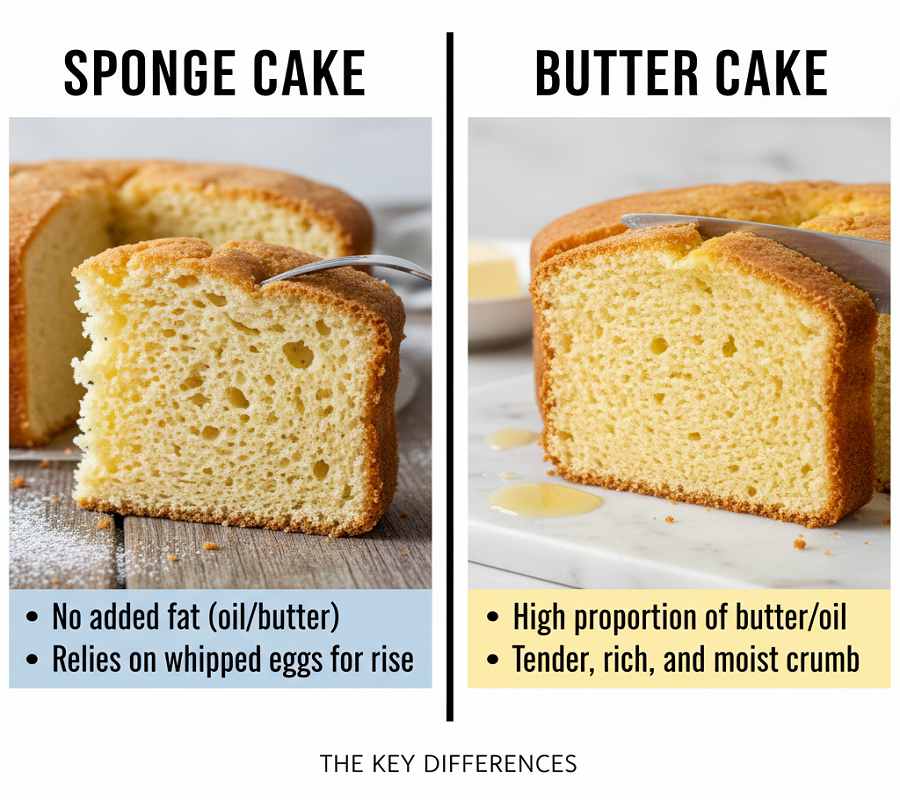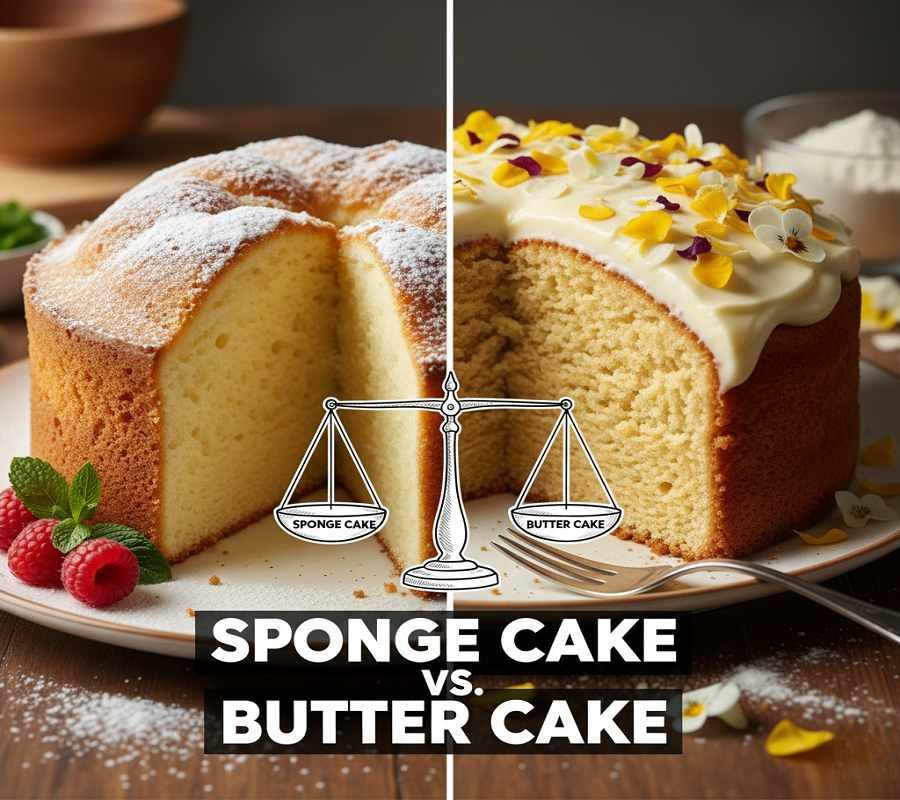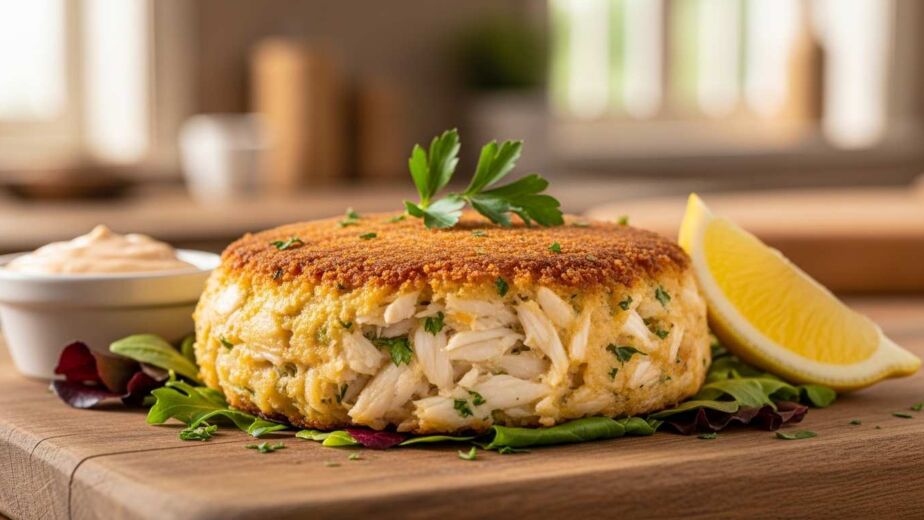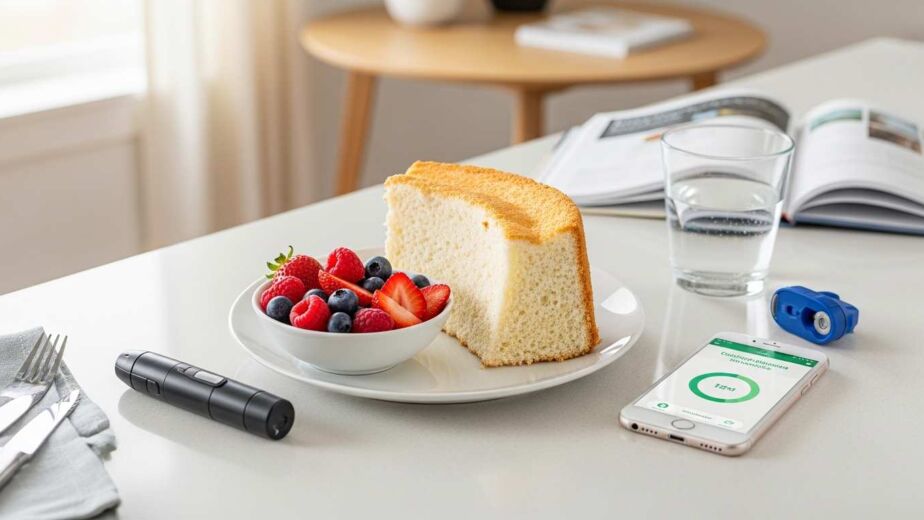If you’re wondering about the difference between sponge cake and butter cake, it comes down to ingredients and texture. Sponge cake is a light, airy “foam” cake made mostly from eggs, sugar, and flour. It gets its rise from whisked egg whites (or whole eggs) and usually contains little to no added fat or baking powder. In contrast, butter cake (also called a shortened cake) relies on butter (or oil) and chemical leaveners. Butter cake recipes cream together butter and sugar, then add eggs, flour, and baking powder or baking soda for rise. The result is a sponge cake that is very airy and fine-textured, versus a butter cake that is denser, richer, and inherently moist.
What is a Sponge Cake?
A sponge cake is essentially a foam cake. It typically contains three main ingredients – flour, sugar, and a lot of eggs – with no baking powder or soda. The key is beating or whisking the eggs (often just the whites, or whites and yolks separately) until very foamy. This whipped egg foam traps air, which leavens the cake as it bakes. Because there’s little to no fat added (no butter or oil), the baked sponge cake comes out dry and springy by design. In fact, its light crumb is meant to be soaked or filled: classic sponge desserts include Victoria sponge or Swiss roll cakes that are layered with jam, cream, or soaked in flavored syrups (like coffee or fruit syrup) to add moisture. (For example, sponge cake “takes well to being soaked with syrups” because it was baked quite dry.)
Some variations blur the lines: for instance, a chiffon cake is like a hybrid sponge. It also uses whipped egg foam for lift, but adds a little oil and baking powder. Likewise, angel food cake is an extreme sponge made from only egg whites (no yolks or added fat), yielding a very tall, cloud-like cake. The common theme is that sponge-style cakes rely on air in eggs (not added fat or baking soda) to become tall and fluffy.
What is a Butter Cake?
Butter cakes (often just called plain cakes in many recipes) are shortened cakes – meaning they include fat (butter, margarine, or oil) which “shortens” gluten and keeps the cake tender. The classic method is to cream room-temperature butter and sugar together until light and fluffy, then beat in eggs, and finally fold in flour mixed with a leavening agent like baking powder. Because of the butter (or oil) and sugar, butter cakes have a high fat content and a fine, moist crumb. Popular butter cakes include pound cake, yellow birthday cake, carrot cake, and more – essentially most traditional frosted layer cakes and loaf cakes. All butter cakes share two common ingredients: butter (or oil) and baking powder/soda for rise.
This combination yields a cake that is heavier and richer. In fact, food writers note that sponge cakes are light and springy (and “won’t hold up to a heavy frosting”), whereas butter cakes are heavier and more dense, with a “hearty weight to each bite,” and can take on thick frostings and glazes easily. The buttery flavor is pronounced too, giving these cakes a sweet, rich taste.
Key Differences at a Glance

-
Leavening: Sponge cakes rise by trapped air in beaten eggs – they use no (or very little) baking powder or baking soda. Butter cakes use chemical leaveners (baking powder or soda) in addition to some air from creaming the butter and eggs.
-
Fat Content: Sponge cakes contain little or no added fat (some sponge recipes use a bit of oil or butter for richness, but most do not). Butter cakes have a high fat content – the butter (or oil) is a main ingredient.
-
Texture/Crumb: Sponge cakes have a light, coarse, spongy texture with big air pockets. Butter cakes have a denser, finer, and more tender crumb. In other words, sponge cakes feel airy and springy, while butter cakes feel moist and substantial.
-
Moisture and Flavor: By design, sponge cakes come out drier and more neutral in flavor, because they are intended to absorb extra moisture from fillings or syrups. Butter cakes emerge moist and rich from the oven on their own, with a buttery flavor. Because of this, butter cakes do not need (and generally should not have) as much soaking – in fact, adding too much liquid to a butter cake can make it gummy. Butter cakes can become “exceptionally moist and do well with many kinds of frostings” without additional syrup.
-
Mixing Method: To make a sponge cake, the batter is made mainly by whisking or folding eggs and sugar into flour, preserving the egg foam. For a butter cake, the butter and sugar are creamed first, which incorporates air, then eggs and dry ingredients are added.
Uses, Examples, and Serving
Because of these differences, sponge cakes and butter cakes are often used in different ways. Sponge cakes (like Victoria sponge, genoise, or angel food) are great for layered desserts where you might brush them with flavored syrup or sandwich them with jam, whipped cream, or custard. They’re also used for rolls (Swiss rolls) and trifles, precisely because their dry, airy texture soaks up toppings and syrups beautifully. (For example, a sponge layered with strawberries and whipped cream is a classic light dessert.) Angel food cake – a type of sponge – stays tall and airy and is usually served plain or with berries and glaze.
On the other hand, butter cakes (such as pound cake, classic yellow cake, red velvet, banana bread, etc.) are sturdy enough to hold rich buttercream, ganache, or fondant. They are the typical cakes for birthdays and weddings. Because they’re already moist, they usually don’t need extra syrup, and they keep well (but beware leaving them too long as they can dry out). Butter cakes can also be baked in loaf pans (like banana bread or lemon pound cake), muffin tins, or layered into tall celebration cakes.
Which Cake Should You Choose?
In summary, choose a sponge cake if you want a light, fluffy cake that can soak up extra flavors (good for layered desserts with cream, fruit, or syrups). Choose a butter cake if you want a rich, tender cake with buttery flavor that stands up to thick frostings and fillings. Both have their own charm: sponge cakes feel delicate and springy, butter cakes feel moist and decadent. Understanding these differences lets you pick the right cake style for your recipe or occasion – now you can confidently bake (or enjoy) whichever style suits your dessert best.



